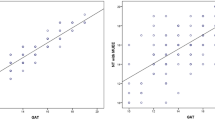Abstract
Graves’ ophthalmopathy (GO) is an autoimmune disease of the retroocular tissue occurring in patients with Grave’s disease leading to exophthalmos. Exophthalmos is usually detected by inspection using Nafziger’s method and objectively measured with Hertel’s exophthalmometry. Here we have described a novel technique “Pen touch test” to clinically diagnose exophthalmos. This cross-sectional study was conducted on patients with suspicious hyperthyroid ophthalmopathy/Grave’s ophthalmopathy (GO) who underwent eye examination by Nafziger’s method and our proposed new method “Pen Touch Test (PTT)”. In this test, a clean ruler or pen is held straight over the middle of orbital ridge touching the superior orbital margin and ipsilateral malar eminence. In normal persons, the ruler or pen touches both the superior orbital margin and ipsilateral malar eminence with or without touching eyelids. In patients with GO, there is true bulging forward of the eyeball. Hence, the ruler or pen cannot be made to touch both upper orbital margin and malar eminence simultanously. The presence and degree of exophthalmos was measured objectively on Hertel’s exophthalmometry, which was considered the “gold standard”. Pen touch test was found to have 100% sensitivity, 100% specificity and 100% Positive Predictive value. Whereas Nafziger’s method had a sensitivity of only 75% compared to Hertel’s exophthalmometry as gold standard test. “Pen touch test” is simple and sensitive method that can be used to screen for exophthalmos in suspected cases of Grave’s ophthalmopathy.



Similar content being viewed by others
References
Kahaly GJ, Diana T, Glang J, Kanitz M, Pitz S, König J (2016) Thyroid stimulating antibodies are highly prevalent in hashimoto’s thyroiditis and associated orbitopathy. J Clin Endocrinol Metab 101(5):1998–2004
Tanda ML, Piantanida E, Liparulo L, Veronesi G, Lai A, Sassi L, Pariani N, Gallo D, Azzolini C, Ferrario M, Bartalena L (2013) Prevalence and natural history of graves’ orbitopathy in a large series of patients with newly diagnosed graves’ hyperthyroidism seen at a single center. J Clin Endocrinol Metab 98(4):1443–1449
Bartley GB (1994) The epidemiologic characteristics and clinical course of ophthalmopathy associated with autoimmune thyroid disease in Olmsted County, Minnesota. Trans Am Opthalmol Soc 92:477–588
De Juan E Jr, Hurley DP, Sapira JD (1980) Racial differences in normal values of proptosis. Arch Intern Med 140(9):1230–1231
Suzuki N, Noh JY, Kameda T et al (2018) Clinical course of thyroid function and thyroid associated-ophthalmopathy in patients with euthyroid Graves' disease. Clin Ophthalmol 19(12):739–746
Barrio JB, Sabater AL, Farriol EB et al (2015) Graves’ ophthalmopathy: VISA versus EUGOGO classification, assessment, and management. J Ophthalmol 2015 (Article ID 249125): 16 pages. https://doi.org/10.1155/2015/249125, 1, 16
Nuo Xu, Yi Cui, Tianlu Xie, Zheng Mi (2018) Comparative efficacy of medical treatments for thyroid eye disease: a network meta-analysis. J Ophthalmol 2018 (Article ID 7184163): 10 pages. https://doi.org/10.1155/2018/7184163, 1, 10
Garrity JA, Fatourechi V, Bergstralh EJ, Bartley GB, Beatty CW, DeSanto LW, Gorman CA (1993) Results of transantral orbital decompression in 428 patients with severe graves’ ophthalmopathy. Am J Opthalmol 116:533–547
Author information
Authors and Affiliations
Corresponding author
Ethics declarations
Conflict of Interest
Kamal Kataria, Santosha Patasani, Komal Gupta, Piyush Ranjan, Anita Dhar, Anurag Srivastava, Radhika Tandon declare that they have no conflict of interest.
Additional information
Publisher’s Note
Springer Nature remains neutral with regard to jurisdictional claims in published maps and institutional affiliations.
Rights and permissions
About this article
Cite this article
Kataria, K., Pattashanee, S., Gupta, K. et al. Pen Touch Test for Detecting Exophthalmos. Indian J Surg 83, 1502–1505 (2021). https://doi.org/10.1007/s12262-021-02751-z
Received:
Accepted:
Published:
Issue Date:
DOI: https://doi.org/10.1007/s12262-021-02751-z




